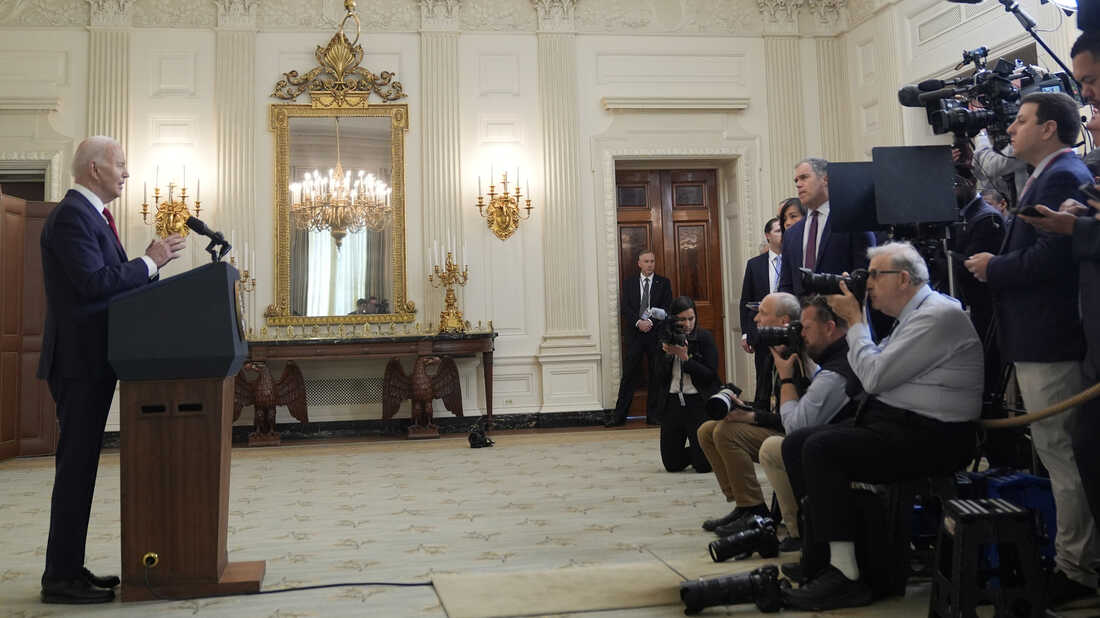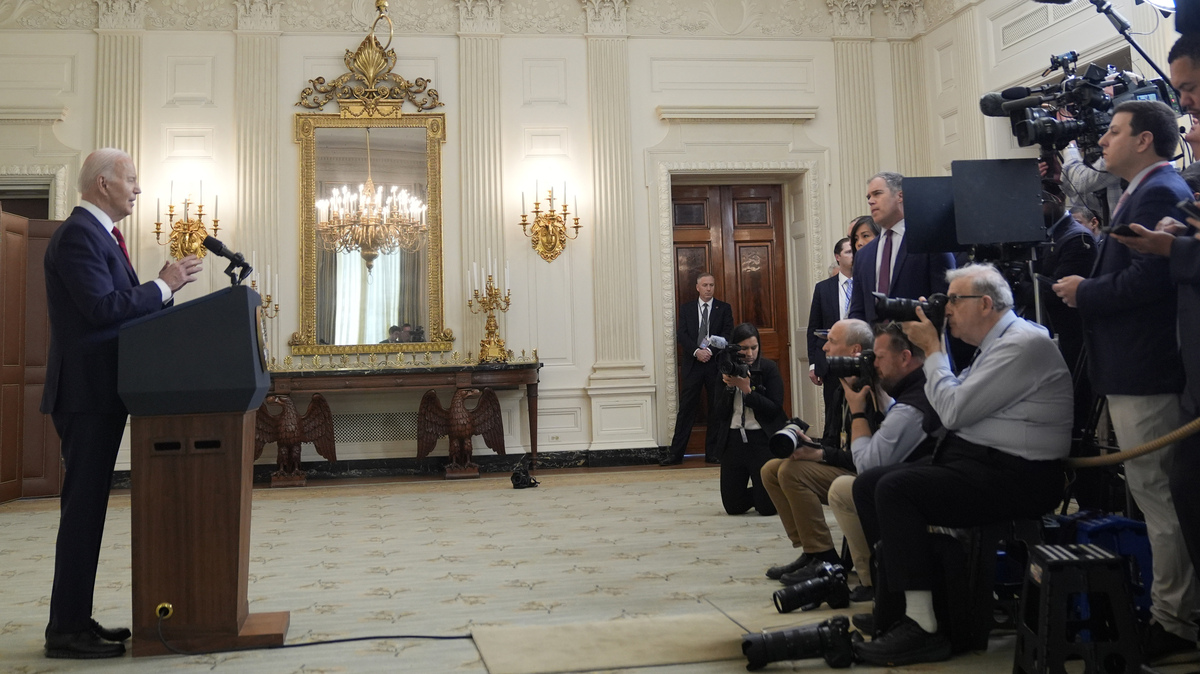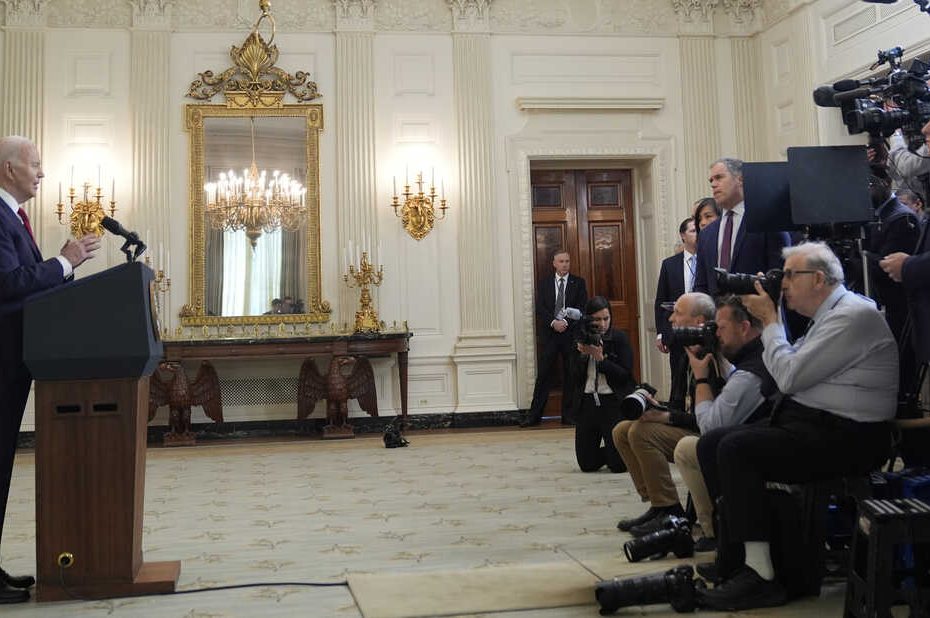
President Biden announces Wednesday the signing of a $95 billion military assistance package for Ukraine, Israel and Taiwan. Ukraine says the aid is critical as it seeks to regain battlefield momentum from Russia.
Evan Vucci/AP
hide title
toggle title
Evan Vucci/AP

President Biden announces Wednesday the signing of a $95 billion military assistance package for Ukraine, Israel and Taiwan. Ukraine says the aid is critical as it seeks to regain battlefield momentum from Russia.
Evan Vucci/AP
After months of opposition from Republicans in Congress, President Biden on Wednesday signed a $95 billion military aid package that will arm Ukraine, Israel and Taiwan.
“When our allies are stronger, we are stronger,” Biden said in remarks at the White House.
Referring to Ukraine, he added: “I’m making sure that shipments begin immediately, in the next few hours, literally a few hours,” Biden said.
The president also reiterated his strong support for Israel.
“I want to make it clear once again that my commitment to Israel is ironclad,” the president said. He cited Iran’s recent airstrike against Israel, which involved more than 300 drones and missiles, although it caused only minimal damage.
Biden has faced heavy criticism from many on the left for supporting additional military assistance to Israel as it wages war against Hamas in Gaza. The Palestinian death toll exceeds 34,000, most of them civilians, according to Gaza health officials.
Biden noted that the bill includes $9 billion for humanitarian assistance around the world, including $1 billion for Gaza.
“We’re going to secure that aid immediately and increase it,” Biden said. “Israel must ensure that all this aid reaches the Palestinians in Gaza, without delay.”
Most of the money goes to Ukraine.
Hardline Republicans in the House had been blocking the measure since Biden proposed it last fall. But the House overwhelmingly approved the measure on Saturday, followed by an equally lopsided vote in the Senate on Tuesday.
Aid to Ukraine, totaling $60.8 billion, represents almost two-thirds of the total. This is seen as urgent in Ukraine’s effort to push back, or at least hold the line, against Russian forces that have had the upper hand in recent months.
The Pentagon immediately announced more than 20 different types of weapons and military equipment to be sent to Ukraine in an initial tranche valued at around $1 billion.
The list includes two types of weapons that Ukraine says it urgently needs.
One is artillery shells. The ground war in eastern Ukraine is largely an artillery war and Russia has a huge advantage.
Ukrainian military officials have spoken of Russian artillery shells outnumbering Ukrainian fire by up to 10 to 1. They say Ukraine has had to ration shells and, in some cases, ran out of ammunition and had to backing out. This has allowed the Russians to be on the offensive in recent months, although progress on the battlefield has been minimal.
The second key weapon is air defense missiles. Ukraine’s limited air defenses have worked extremely well over the past two years, according to military analysts, but it has recently been vulnerable to attacks on cities and the power grid.
Ukrainian President Volodymyr Zelenskyy said Russia recently fired 11 missiles in a sustained attack on a civilian power plant on the outskirts of the capital, kyiv.
The Ukrainians shot down the first seven incoming missiles, he said, but then ran out of weapons. The last four Russian missiles hit the plant and caused power outages.
Ukraine also expects to receive ATACMS, an advanced US missile that can travel nearly 200 miles.
Ukraine has been asking for this weapon. The Biden administration has not publicly announced that it will provide it and it was not included in the list the Pentagon released Wednesday.
Britain has sent a similar missile, the Storm Shadow, which is credited with hitting Russian bases and ships far behind the front lines.
John Herbst, former U.S. ambassador to Ukraine, says the military package is important for reasons that go far beyond the weapons being sent to that country.
“Over the last few months we’ve had this extraordinary spectacle of leaders coming from Europe, Japan and elsewhere, pleading with the United States to act as leader of the free world,” said Herbst, who now serves on the Atlantic Council. He called it “unprecedented since the end of World War II. It’s not a good look for the United States. If we give Ukraine just the help we’ve given it over the last two years, there’s no way in the world (Russian leader Vladimir) Putin could win this war.”
Ukraine expected to target Crimea and Black Sea
Military analysts do not predict major changes on the eastern Ukrainian front. Despite ongoing fighting, both sides are entrenched and the lines have moved little in the past 18 months.
Ukraine’s main objective will likely be to stabilize conditions in this region.
According to the fall, weapons supplied by the US and also by European countries could improve Ukraine’s prospects in the south, especially in the Crimean peninsula and the Black Sea.
“Putin has a real vulnerability in Crimea and southern Ukraine,” he said. “He needs to keep his troops there supplied. Ukraine can make that supply route much less efficient and therefore hamper Russian military operations.”
Ukraine launched a major offensive in eastern and southern Ukraine last summer to great fanfare, but made only modest gains, well below expectations.
Herbst said the current influx of American weapons is not likely to determine the outcome of the war. He sees no realistic prospects for a resolution (on the battlefield or through negotiations) any time soon.
But he said U.S. support sends a strong signal and will give Ukraine the resources to keep fighting this year and beyond.
